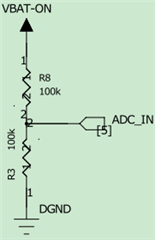hello, I have two questions for SAADC of nrf52832 when we use nrf52832 SAADC for voltage measurement.
The AIN0 is connected to the pin to be measured(the voltage is about 1.5V, use SE mode, so the negative
input will be shorted to ground internally ), the output of SAADC is 850(the result beating frequently between 850 to 856).
my SAADC config is bellow:
NRF_SAADC->CH[channel].CONFIG = ((SAADC_CH_CONFIG_RESN_Bypass << SAADC_CH_CONFIG_RESN_Pos)|
(SAADC_CH_CONFIG_RESP_Bypass << SAADC_CH_CONFIG_RESP_Pos)|
(SAADC_CH_CONFIG_GAIN_Gain1_3<< SAADC_CH_CONFIG_GAIN_Pos)|
(SAADC_CH_CONFIG_REFSEL_Internal<<SAADC_CH_CONFIG_REFSEL_Pos)|
(SAADC_CH_CONFIG_TACQ_10us<< SAADC_CH_CONFIG_TACQ_Pos)|
(SAADC_CH_CONFIG_MODE_SE<<SAADC_CH_CONFIG_MODE_Pos) );
NRF_SAADC->CH[channel].PSELP = SAADC_CH_PSELP_PSELP_AnalogInput0;
NRF_SAADC->CH[channel].PSELN = SAADC_CH_PSELP_PSELP_NC;
NRF_SAADC->RESULT.MAXCNT = 1;
NRF_SAADC->RESOLUTION = SAADC_RESOLUTION_VAL_10bit;
NRF_SAADC->OVERSAMPLE = SAADC_OVERSAMPLE_OVERSAMPLE_Bypass;
NRF_SAADC->ENABLE = (SAADC_ENABLE_ENABLE_Enabled << SAADC_ENABLE_ENABLE_Pos);
NRF_SAADC->INTENSET = SAADC_INTENSET_END_Msk;
then read the result:
NRF_SAADC->TASKS_START = 1;
NRF_SAADC->TASKS_SAMPLE = 1;
uint32_t saadc_timeout = 100000;
while ((NRF_SAADC->EVENTS_END == 0U)&& (saadc_timeout > 0))
{
saadc_timeout--;
}
NRF_SAADC->EVENTS_END = 0;
NRF_SAADC->RESULT.PTR = (uint32_t)saadc_value_data;
My question is :
1) RESULT = [V(P) – V(N) ] * GAIN/REFERENCE * 2(RESOLUTION - m)
RESULT = 850/1024 = 0.83
[V(P) – V(N) ] * GAIN/REFERENCE * 2(RESOLUTION - m) = 1.5V * Gain1_3 / (0.6V * 2) = 0.417, it's not equall to RESULT, why?
2) The SAADC output is beating frequently between 850 to 856(for example 851,853,855...), is it normal?



